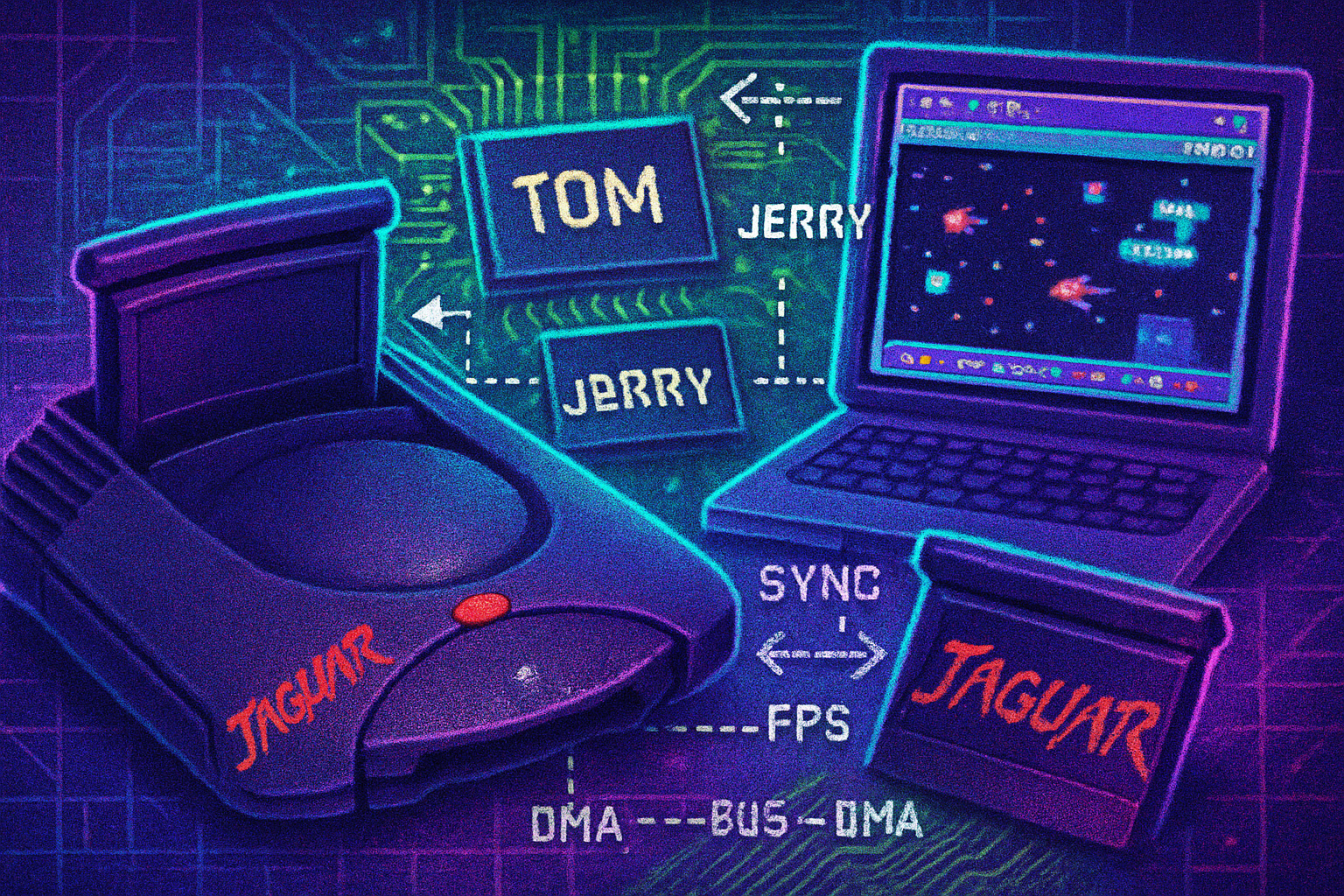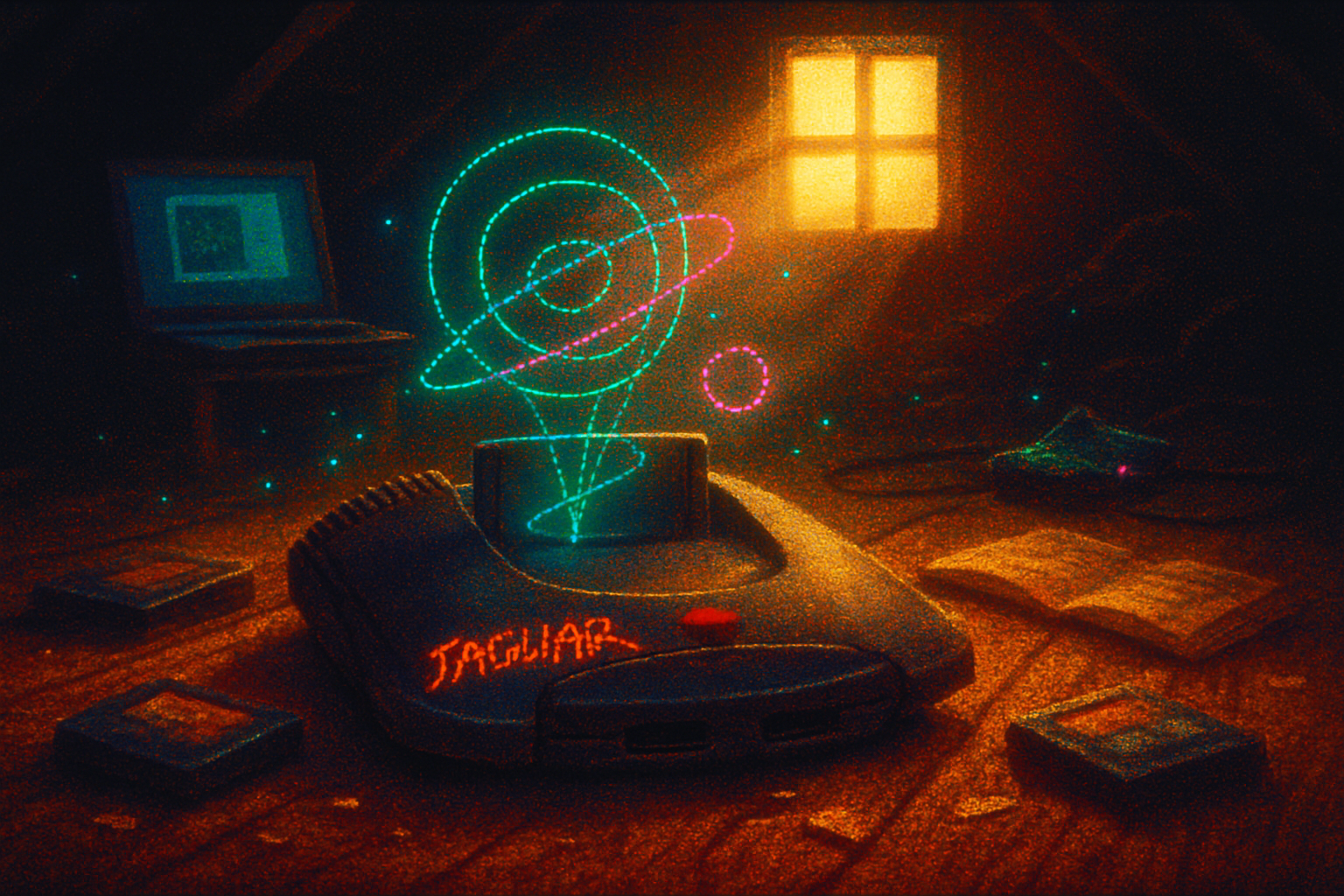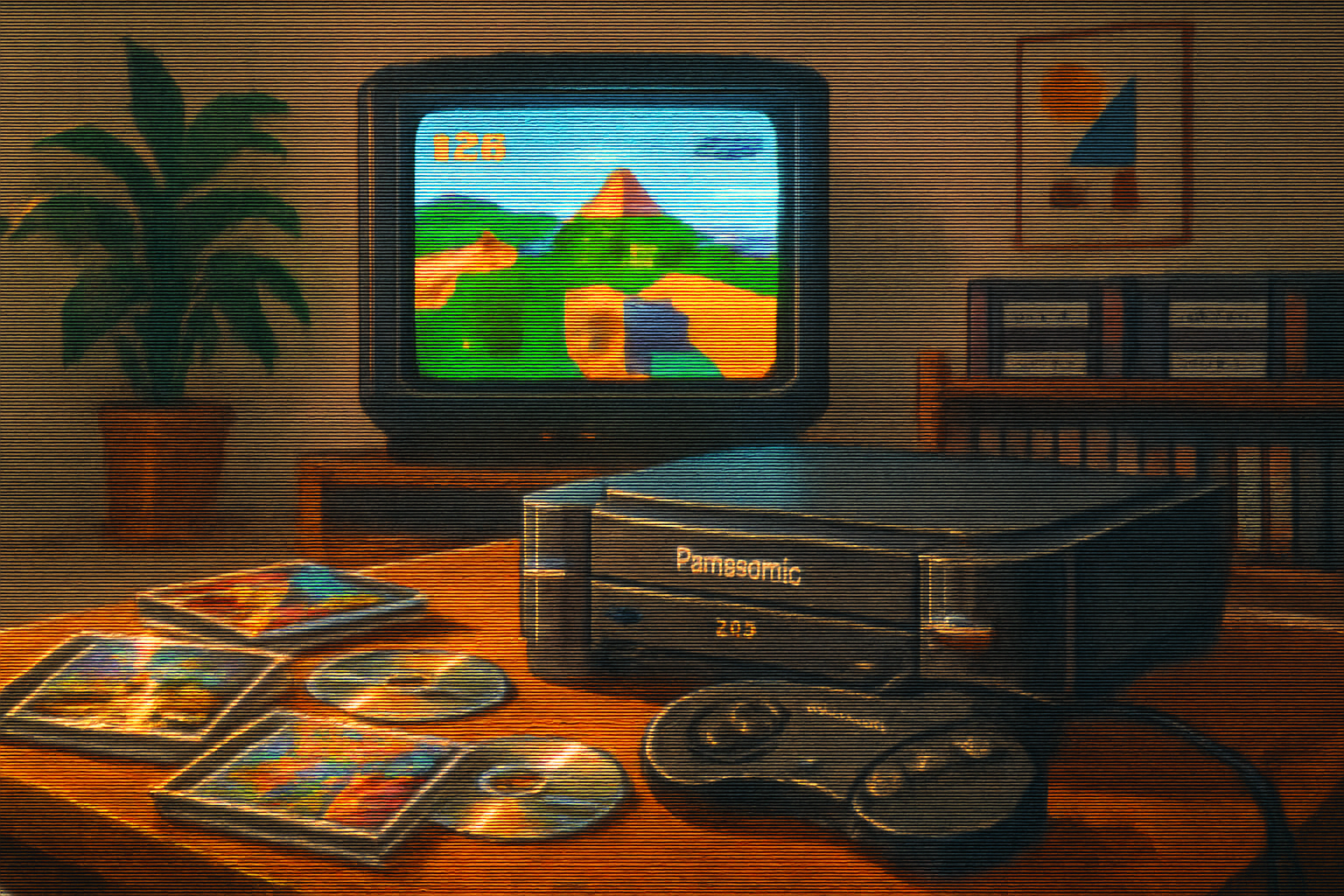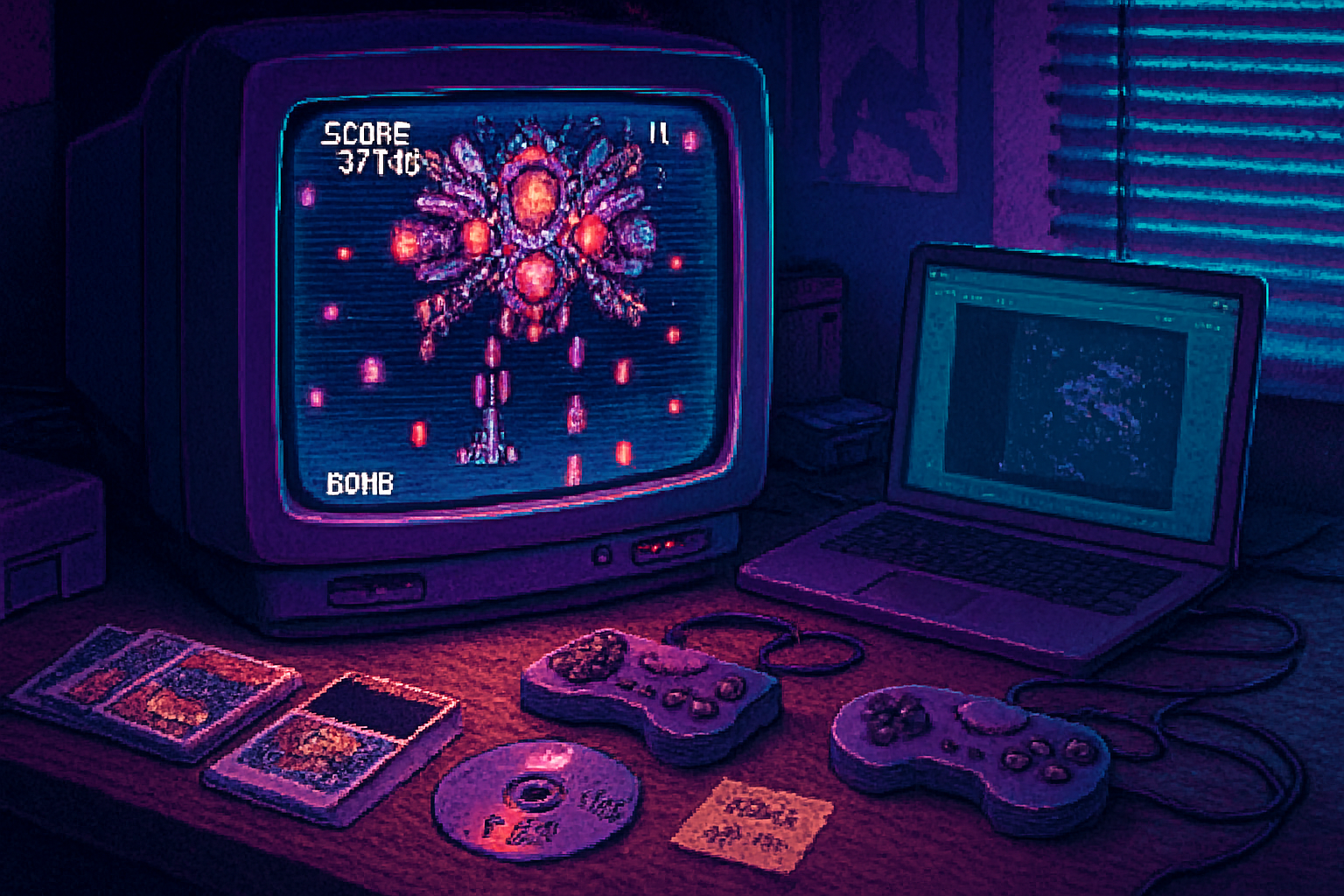· retrogaming · 7 min read
The Rise and Fall of Atari Jaguar: A Deep Dive into Emulation
A technical and historical exploration of the Atari Jaguar: why the console failed commercially, what made its hardware unique, and how modern emulators and preservation projects overcome the Jaguar’s unusual architecture to keep its games playable today.

Introduction
The Atari Jaguar launched in 1993 with a bold claim: it was the world’s first 64-bit console. The promise grabbed headlines, but the system’s real story was far messier - a complex custom architecture that was difficult to program for, a weak software library, and marketing that couldn’t keep pace with rivals. Ironically, the same unusual hardware that helped doom the Jaguar has made emulation both a fascinating technical challenge and an important preservation effort.
This article walks through the Jaguar’s history, what made its hardware unique, why it failed in the market, and how emulation projects have tackled the difficult task of reproducing its behavior faithfully.
A succinct history of the Atari Jaguar
Atari released the Jaguar in late 1993 (North America) into a market that was about to be remade by the PlayStation and Sega Saturn. Despite an aggressive marketing line - often simplified to “64-bit” - the Jaguar struggled to deliver the depth and polish of competing systems.
Several factors contributed to its commercial failure:
- A sparse first-party and third-party game library
- Confusing marketing and unrealistic expectations around “64-bit”
- Difficult hardware that created a steep learning curve for developers
- Strong competition from Sony and Sega
For an overview of the console and its place in gaming history, see the Atari Jaguar entry on Wikipedia and the Jaguar section on AtariAge.
- Atari Jaguar (Wikipedia): https://en.wikipedia.org/wiki/Atari_Jaguar
- AtariAge - Jaguar section: https://www.atariage.com/consoles/jaguar/
What made the Jaguar unusual (and powerful on paper)
At its core the Jaguar was a heterogeneous system with multiple processors and specialized custom chips. The key pieces were:
- Motorola 68000 - a familiar 16/32-bit CPU often used as a system controller (clocked relatively low)
- “Tom” - a custom chip that handled object processing, geometry and graphics-related work (sometimes described as a GPU-like block)
- “Jerry” - a custom digital signal processor (DSP) handling audio and other data-processing tasks
- Custom blitter/object processor architecture - instead of tile-based, many graphics operations were driven by object lists and blitter operations
The design allowed very high performance for specific workloads, especially if a developer could fully exploit Tom and Jerry in parallel. But that same parallelism made programming and debugging far harder than on more conventional console architectures.
For a hardware-focused breakdown, the GameTech Wiki’s Jaguar page is a helpful reference: https://emulation.gametechwiki.com/index.php/Atari_Jaguar
Why the Jaguar was hard to develop for
The Jaguar’s heterogenous model created several practical problems:
- Many processors, different ISAs - developers needed to coordinate code across the 68000, Tom and Jerry, and sometimes custom microcode
- Sparse tooling - Atari’s official SDK and libraries were limited compared with the sophisticated toolchains that would become available for PlayStation and Saturn
- Timing sensitivity - many games relied on precise timing and hardware quirks to get performance, making correct behavior fragile
- Documentation and community knowledge were limited, especially early in the console’s lifespan
Because of these hurdles, many titles ended up leaning on the 68000 for game logic and on simpler rendering paths - squandering the Jaguar’s theoretical power.
Emulation: preserving a messy, timing-sensitive beast
Emulating the Jaguar is both conceptually simple and practically painful: conceptually simple because emulator authors replicate hardware behavior in software; painful because Jaguar hardware is asynchronous, timing-sensitive, and poorly documented in places.
Key technical hurdles:
Multi-processor synchronization
- Jaguar games expected tight cooperation between the 68000, Tom, and Jerry. To produce correct behavior, emulators must synchronize all processors with sufficient granularity so that reads, writes, interrupts, and DMA happen at the right times.
- Simple approaches that run each CPU at coarse-grained quanta can miss races or ordering-dependent behavior. The result - visual corruption, sound glitches, or crashes.
Cycle accuracy vs. performance
- Cycle-accurate emulation reproduces the exact timing (down to individual CPU cycles) of hardware operations. It’s the gold standard for compatibility and correctness, but it’s expensive in CPU cost.
- High-level or timing-approximate emulation is much faster, but can fail on software that depends on precise timing. Emulators for Jaguar face a tradeoff - be fast and miss edge-case games, or be slow and accurate.
See the GameTech Wiki’s cycle-accurate page for the implications: https://emulation.gametechwiki.com/index.php/Cycle-accurate_emulation
Unusual graphics pipeline
- Tom and Jaguar’s “object processor” and blitter model differs from tilemaps and polygon GPUs. Emulating the object processor requires more than just dumping polygons; it must reproduce how the hardware composes objects, priorities, and blending.
Undocumented behavior and quirks
- Early hardware often had quirks that game developers used intentionally. If the emulator doesn’t reproduce undocumented side-effects, game behavior can differ.
Limited reference hardware and test ROMs
- Emulator authors rely on hardware tests, dumps, and community reports to validate behavior. For less-popular systems there are fewer test suites and less community knowledge to triangulate on correct behavior.
Different endianness and memory-mapping peculiarities
- Mixing processors (e.g., a big-endian 68000 with differently-behaving custom chips) can produce subtle byte-order and memory ordering issues that are easy to get wrong.
Strategies used by successful Jaguar emulators
Over the years, community emulation projects have adopted several approaches to tackle these problems.
Incremental accuracy improvements
- Start with a workable high-level emulation to run many titles fast and then progressively add timing fixes, hook up accurate DMA, and replicate edge-case behavior.
CPU interleaving and fine-grained scheduling
- Emulators often run CPUs in short time slices and frequently synchronize shared bus accesses. A typical loop will execute a small number of cycles on CPU A, then CPU B, and so on, checking for interrupts and shared memory access in between.
Example pseudocode for an interleaved scheduler:
while (frame_not_done) { run_cycles(68000, quantum_cycles); run_cycles(Tom, quantum_cycles); run_cycles(Jerry, quantum_cycles); handle_DMA_and_interrupts(); }Choosing the right quantum (small enough to catch races, large enough for performance) is a tuning problem.
Targeted cycle emulation for hot paths
- Rather than being fully cycle-accurate everywhere, some emulators emulate particularly timing-sensitive hardware paths at cycle granularity while keeping other subsystems higher-level. This hybrid approach balances compatibility and speed.
Reverse engineering and community knowledge
- Developers read disassembled game code, observe behavior on real hardware, and share test ROMs to reproduce bugs. This often fills gaps left by incomplete official documentation.
Dynamic recompilation (JIT) for CPUs
- To gain performance, some emulators implement dynamic recompilers for the 68000 or DSP code, translating guest code to host machine code at runtime while retaining synchronization hooks.
Leveraging multi-threading where safe
- Running separate emulated processors on different host threads can increase performance but requires careful synchronization to avoid introducing nondeterministic races.
Notable projects and approaches
Virtual Jaguar is one of the long-running Jaguar emulators that made the platform accessible on desktop machines. Its goal was broad compatibility and practicality; later projects and improvements have moved toward better accuracy while keeping performance reasonable: http://virtualjaguar.sourceforge.net/
The numerous improvements in preservation-focused multi-system emulators (such as MAME) show another path: prioritizing correctness and documentation so that behavior matches hardware as closely as possible (at the cost of higher host requirements). See MAME: https://www.mamedev.org/
Community resources and technical write-ups on Jaguar internals and emulation techniques are available at GameTech Wiki: https://emulation.gametechwiki.com/index.php/Atari_Jaguar
Preservation, legality, and the role of emulation
Emulation is more than a technical exercise; it’s preservation. Without emulation, many Jaguar titles would be effectively inaccessible except to those who can find and maintain aging hardware. Emulation enables:
- Access to historically important games
- Development of tools to analyze and document hardware behavior
- Homebrew and archival projects that keep a console’s story alive
Legal issues complicate the story. Distributing copyrighted game ROMs is widely restricted; emulator cores themselves are legal in most jurisdictions. Preservation projects often emphasize legal frameworks - working with rights holders when possible and focusing on archival research and documentation.
The future: FPGA recreation and continued refinement
Two trends help Jaguar preservation:
FPGA implementations - replicating hardware in an FPGA can produce behavior closer to original silicon without the overhead of software emulation. FPGA cores aim to recreate hardware timing and behavior at the logic level and are a promising path for faithful preservation.
Continued emulator refinement - as emulation projects add more accurate timing, better DMA emulation, and more complete reconstructions of Tom/Jerry behavior, compatibility will improve. The community’s incremental approach - trading runtime performance for correctness where needed - has a strong track record.
Conclusion
The Atari Jaguar is an excellent case study of how ambitious hardware can both inspire and confound. The console failed commercially because its promise outpaced developer support, tooling, and software libraries. But that same unconventional architecture has made it an attractive and instructive subject for emulator authors and preservationists.
Emulating the Jaguar requires careful thinking about multi-processor synchronization, timing, and undocumented hardware behavior. The successes so far - from practical desktop emulators to preservation-minded projects - show that even the most eccentric consoles can be kept alive through careful engineering, reverse engineering, and community effort.
If you’re interested in digging deeper into Jaguar internals or emulation techniques, the resources linked above are good starting points.
References
- Atari Jaguar - Wikipedia: https://en.wikipedia.org/wiki/Atari_Jaguar
- AtariAge (Jaguar section): https://www.atariage.com/consoles/jaguar/
- GameTech Wiki - Atari Jaguar (emulation-focused documentation): https://emulation.gametechwiki.com/index.php/Atari_Jaguar
- GameTech Wiki - Cycle-accurate emulation: https://emulation.gametechwiki.com/index.php/Cycle-accurate_emulation
- Virtual Jaguar project: http://virtualjaguar.sourceforge.net/
- MAME (multi-system accuracy-focused emulator project): https://www.mamedev.org/



